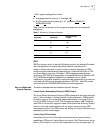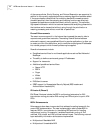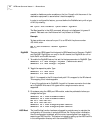
New Features 13
< 56 bit support packages/kits contain:
■ A package identifier ending in ‘E’ (example, NE)
■ A 3CR number containing/ending in ‘91’ (examples, 3CR856791,
3CR
6452P91FLASH)
Table 3 contains a summary of the encryption strengths and the associated
package ids.
RSVP
RSVP is a dynamic quality of service (QoS) setup protocol that enables IPv4-based
real time applications to reserve resources at network nodes along the
sender-to-receiver data path to meet its quality of service requirements. RSVP
monitors and enforces bandwidth reservations for outbound QoS traffic on PPP
and Frame Relay virtual ports. The Phase 1 RSVP message processing engine
conforms to RFC 2205 and its application to Integrated Services as defined in RFC
2210. NETBuilder bridge/router-specific flow admission control, packet
classification, and packet scheduling mechanisms are implemented to provide the
controlled-load QoS control services as specified in RFC 2211. Both IPv4 unicast
and multicast (over DVMRP/MOSPF domains) flows are supported.
New and Enhanced
Protocol Features
This section describes new and enhanced protocol features.
Virtual Router Redundancy Protocol (VRRP) Phase 2
The Virtual Router Redundancy Protocol (VRRP) is designed to eliminate the single
point of failure inherent in the static default routed environment. VRRP specifies
an election protocol that dynamically assigns responsibility for a virtual router to
one of the VRRP routers on a LAN. This is the second phase of VRRP. This phase
adds FDDI to the currently supported media (Ethernet and Fast Ethernet). Phase II
(similar to the initial implementation) will not support source route for VRRP
advertisements (that is, the VRRP routers that belong to the same VRID cannot be
separated by source route bridges.)
Virtual Circuit Prioritization
Frame Relay Virtual Circuit Prioritization extends the current queue handling
capabilities of PPP ports to Frame Relay virtual circuits. The FR virtual circuit can be
either a FR virtual port or a virtual circuit associated only with the parent port. All
Table 3 Summary of Encryption Strengths
Algorithm Package ID
Encryption Key
Length
RC4 xE 40
xS 128
RC5 xE 56
xS 128
DES xE 56
xS 56
3DES (2 key) xS 112


















